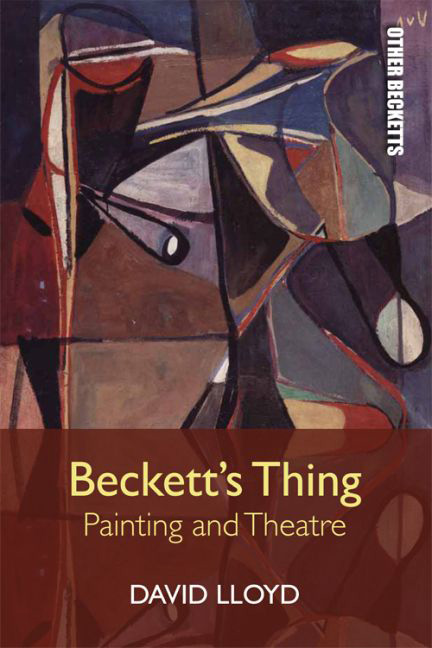Book contents
- Frontmatter
- Contents
- List of Figures
- Acknowledgements
- Other Becketts: Series Preface
- Introduction: The Painted Stage – Beckett's Visual Aesthetics
- 1 Republics of Difference: Yeats, MacGreevy, Beckett
- 2 Beckett's Thing: Bram van Velde and the Gaze
- 3 ‘Siege laid again’: Arikha's Gaze, Beckett's Painted Stage
- Conclusion: The Play's the Thing
- Bibliography
- Index
Introduction: The Painted Stage – Beckett's Visual Aesthetics
Published online by Cambridge University Press: 10 May 2017
- Frontmatter
- Contents
- List of Figures
- Acknowledgements
- Other Becketts: Series Preface
- Introduction: The Painted Stage – Beckett's Visual Aesthetics
- 1 Republics of Difference: Yeats, MacGreevy, Beckett
- 2 Beckett's Thing: Bram van Velde and the Gaze
- 3 ‘Siege laid again’: Arikha's Gaze, Beckett's Painted Stage
- Conclusion: The Play's the Thing
- Bibliography
- Index
Summary
The work considered as pure creation, and whose function ceases with its genesis, is consigned to nothingness. A single art lover (a wellinformed one) would have saved it. Just one of these gentlemen, faces hollowed by unvalidated enthusiasms, feet flattened by innumerable stations, fingers worn by fifty franc catalogues, who look first from far away, then close up, and who, in particularly thorny cases, assess with their thumbs the depth of the impasto.
Beckett's ironic but affectionate sketch of the art lover, this ‘inoffensive nutcase who runs, as others do to the cinema, to the galleries, the museum, and even into churches’ for the pleasure of viewing art, is as much a self-portrait as a satire. It captures not only the reality of his own life-long love of painting, his genuine connoisseurship, and the independence of his critical views, but also the quality of attention that he was capable of giving to an artwork. It has often been noted that Beckett could stand for hours at a time before a canvas, absorbing its formal qualities, its material relations and rhythms as much as whatever image it conveyed. Painting was in every sense Beckett's ‘thing’: he never seems to have lost his engagement either with individual paintings, or with the aesthetic questions that the contemporary fate of painting as an art form imposed. And his own work in the theatre gives new meaning to the well-worn phrase ‘the painted stage’. Beckett's theatre, for stage and for film or television, this book insists, is not merely like painting or based on paintings, but is its own form of visual art. Visual art in painting and theatre furnished him with the space for an intense mode of thinking that is not confined to formal aesthetic appreciation, formidable as his capacity for that was. His absorption before paintings, his focused concentration on their singular existence as things in and of themselves, became the means to explore a crisis in the modern subject that he early on named ‘the new thing that has happened’ and which would be the focus of his critical writing into the post-war period.
- Type
- Chapter
- Information
- Beckett's ThingPainting and Theatre, pp. 1 - 26Publisher: Edinburgh University PressPrint publication year: 2016



